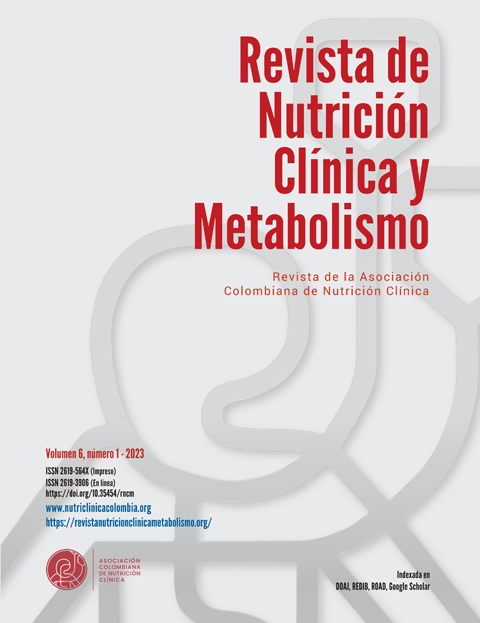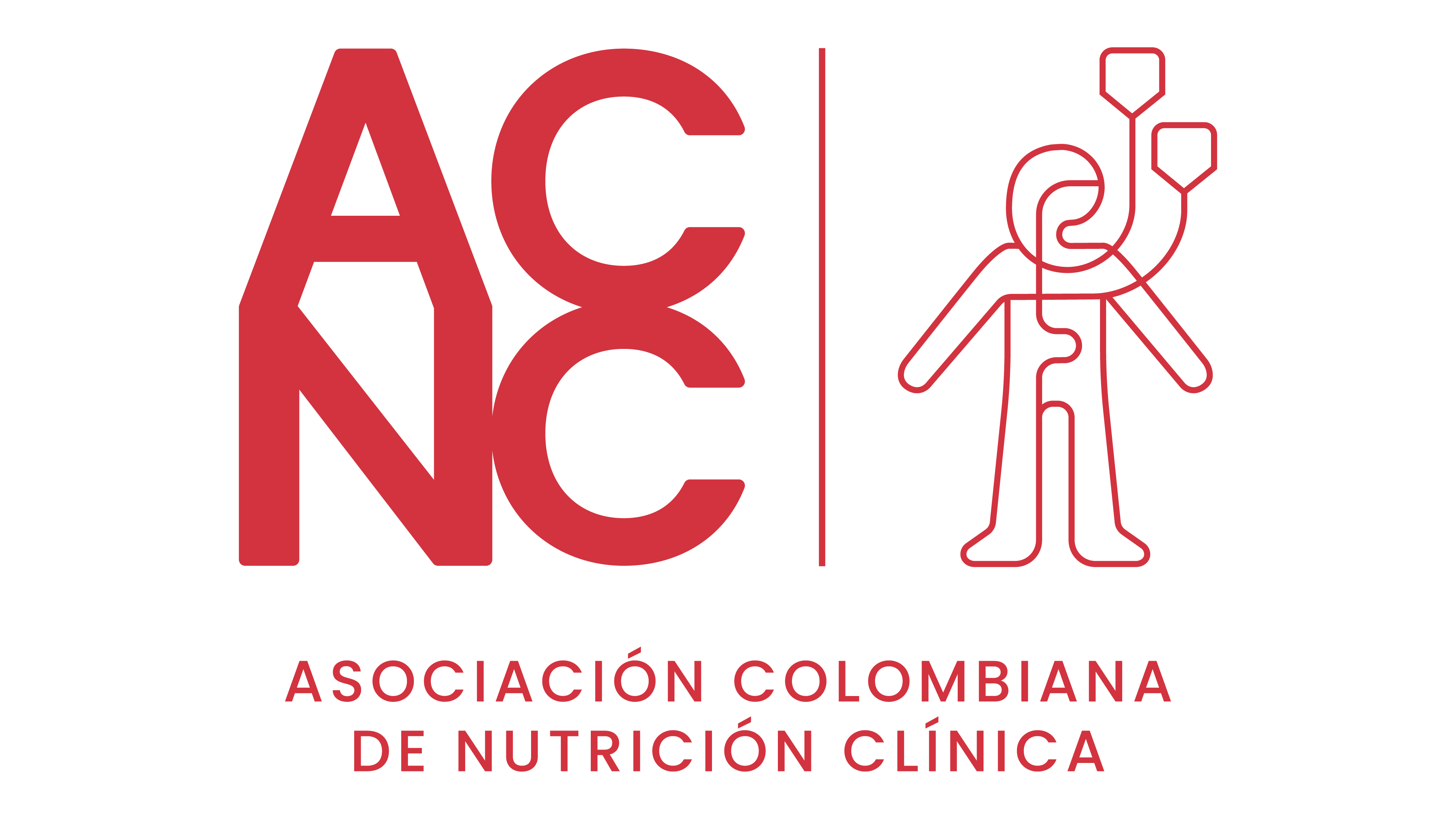Evaluación antropométrica de la adiposidad corporal y el riesgo cardiovascular en población adulta de Neiva, Colombia
DOI:
https://doi.org/10.35454/rncm.v6n1.449Palabras clave:
Obesidad, Obesidad abdominal, Sobrepeso, Adiposidad, Ejercicio fisicoResumen
Introducción: el sobrepeso y la obesidad son enfermedades crónicas no transmisibles (ECNT) que en la actualidad poseen dimensiones pandémicas y se constituyen en importantes factores de riesgo cardiometabólicos para el desarrollo de otras ECNT.
Objetivos: estimar la prevalencia de adiposidad corporal y riesgo cardiovascular mediante los índices IMC, ICC, ICA, IPM y PA y, a su vez, explorar la asociación de tales índices con información sociodemográfica, calidad de la dieta e inactividad física.
Métodos: este fue un estudio de corte transversal de prevalencia realizado en 971 adultos de ambos sexos, provenientes del área urbana de Neiva, desde junio de 2018 a junio de 2019. Los profesionales de la salud realizaron antropometría para calcular los índices anteriormente mencionados empleando protocolos estandarizados. Se utilizaron puntos de corte validados para la población latinoamericana y colombiana para la clasificación en normopeso, sobrepeso, obesidad, obesidad abdominal y riesgo cardiovascular.
Resultados: se registraron las siguientes prevalencias: 56,5 % de exceso de peso (39,5 % de sobrepeso y 17 % de obesidad), 48 % de obesidad abdominal, 41,1 % de normopeso, 2,4 % de bajo peso, 68,5 % de riesgo cardiovascular (43 % de riesgo cardiovascular alto y 21,7 % de riesgo cardiovascular muy alto), 63,8 % de calidad regular y mala de la dieta y 57 % de inactividad física. Los índices anteriormente mencionados se asociaron con aumento de la edad, sexo masculino, aumento de la adiposidad corporal, calidad de la dieta e inactividad física.
Conclusiones: Las altas prevalencias para exceso de peso, sobrepeso, obesidad y riesgo cardiovascular observadas en adultos de Neiva se deben en parte a la alta proporción de dieta regular y de mala calidad e inactividad física.
Descargas
Citas
Mechanick JI, Hurley DL, Garvey WT. Adiposity-Based Chronic Disease as a New Diagnostic Term: The American Association of Clinical Endocrinologists and American College of Endocrinology Position Statement. Endocr Pract. 2017;23(3):372-78.
World Health Organization (WHO). World health statistics 2022: monitoring health for the SDGs, sustainable development goals. [Internet]. Geneva: WHO; 2022. Licence: CC BY-NC-SA 3.0 IGO. 131 p. Disponible en: https://www.who.int/publications/i/item/9789240051157
World Obesity Federation (WOF). World Obesity Atlas 2022. [Internet]. London: WOF; 2022. Disponible en: https://www.worldobesity.org/resources/resource-library/world-obesity-atlas-2022
World Health Organization (WHO). Global Status Report on noncommunicable diseases 2014. [Internet]. Geneva: WHO; 2014. 280 p. [citado el 1 de noviembre de 2022] Disponible en: https://apps.who.int/iris/handle/10665/148114
World Health Organization (WHO). World health statistics 2018: monitoring health for the SDGs, sustainable development goals. 86 p. [Internet]. Licence: CC BY-NC-SA 3.0 IGO. [citado el 1 de noviembre de 2022]. Disponible en: https://apps.who.int/iris/handle/10665/272596
Abarca L, Abdeen ZA, Hamid ZA, Abu-Rmeileh NM, Acosta B, Acuin C, et al. Worldwide trends in body-mass index, underweight, overweight, and obesity from 1975 to 2016: a pooled analysis of 2416 population-based measurement studies in 128.9 million children, adolescents, and adults. Lancet. 2017;390(10113):2627-642.
Global Burden of Disease Collaborative Network. Global Burden of Disease Study 2016 (GBD 2016) Cause-Specific Mortality 1980-2016. [Internet]. Seattle, United States: Institute for Health Metrics and Evaluation (IHME), 2017 [citado el 1 de noviembre del 2022]. Disponible en: https://ghdx.healthdata.org/record/ihme-data/gbd-2016-cause-specific-Mortality-1980-2016
Jiwani SS, Carrillo-Larco RM, Hernández-Vásquez A, Barrientos-Gutiérrez T, Basto-Abreu A, Gutiérrez L, et al. The shift of obesity burden by socioeconomic status between 1998 and 2017 in Latin America and the Caribbean: a cross-sectional series study. Lancet Glob Health. 2019;7(12):e1644-e1654. doi: 10.1016/S2214-109X(19)30421-8
GBD 2017 Risk Factor Collaborators. Global, regional, and national comparative risk assessment of 84 behavioural, environmental and occupational, and metabolic risks or clusters of risks for 195 countries and territories, 1990-2017: a systematic analysis for the Global Burden of Disease Study 2017. Lancet. 2018;392(10159):1923-994. doi: 10.1016/S0140-6736(18)32225-6
Guthold R, Stevens GA, Riley LM, Bull FC. Worldwide trends in insufficient physical activity from 2001 to 2016: a pooled analysis of 358 population-based surveys with 1·9 million participants. Lancet Glob Health. 2018;6(10):e1077-e1086. doi: 10.1016/S2214-109X(18)30357-7
Kovalskys I, Fisberg M, Gómez G, Pareja RG, Yépez MC, Cortés LY, et al. Energy intake and food sources of eight Latin American countries: results from the Latin American Study of Nutrition and Health (ELANS). Public Health Nutr. 2018;21(14):2535-547.
Chacín M, Carrillo S, Arenas V, Martínez M, Hernández J, Anderson H, et al. Prevalencia de sobrepeso y obesidad en escolares de San José de Cúcuta, Norte de Santander, Colombia. Rev. Latinoam. de Hipertens. 2020;15(5):315-21. doi: 10.5281/zenodo.4484300
Jimenez-Mora MA, Nieves-Barreto LD, Montaño-Rodríguez A, Betancourt-Villamizar EC, Mendivil CO. Association of Overweight, Obesity and Abdominal Obesity with Socioeconomic Status and Educational Level in Colombia. Diabetes Metab Syndr Obes. 2020;13:1887-898. doi: 10.2147/DMSO.S244761
Instituto Colombiano de Bienestar Familiar (ICBF), Ministerio de Salud y Protección Social, Instituto Nacional de Salud de Colombia, et al. Encuesta Nacional de la Situación Nutricional en Colombia-ENSIN 2015. 683 p. [Internet] 2015 [citado el 4 de abril de 2022]. Disponible en: https://www.minsalud.gov.co/sites/rid/Lists/BibliotecaDigital/RIDE/VS/ED/GCFI/documento-metodologico-ensin-2015.pdf
Gil-Rojas Y, Garzón A, Hernández F, Pacheco B, González D, Campos J, et al. Burden of Disease Attributable to Obesity and Overweight in Colombia. Value Health Reg Issues. 2019;20:66-72. doi: 10.1016/j.vhri.2019.02.001
Ley 1355 del 14 de octubre de 2009. Diario oficial de la República de Colombia. Año CXLIV No. 47.502. [Internet] 2009. [citado el 4 de abril de 2022]. ISSN 0122-2112. 32 páginas. Disponible en: https://www.icbf.gov.co/cargues/avance/docs/ley_1355_2009.htm#:~:text=Derecho%20del%20Bienestar%20Familiar%20%5BLEY_1355_2009%5D&text=Por%20medio%20de%20la%20cual,su%20control%2C%20atenci%C3%B3n%20y%20prevenci%C3%B3n.
Powell-Wiley TM, Poirier P, Burke LE, Després JP, Gordon-Larsen P, Lavie CJ, et al. Obesity and Cardiovascular Disease: A Scientific Statement From the American Heart Association. Circulation. 2021;143(21):e984-e1010. doi: 10.1161/CIR.0000000000000973
Tarqui C, Álvarez D, Espinoza P. Riesgo cardiovascular según circunferencia abdominal en peruanos. An Fac med. 2017;78(3):287-91. doi: 10.15381/anales.v78i3.13760
FAO, OPS, WFP y UNICEF. Panorama de la seguridad alimentaria y nutrición en América Latina y el Caribe 2019. [Internet] Santiago, 2019. Licencia: CC BY-NC-SA 3.0 IGO. 136 p. [citado el 1 de noviembre de 2022] Disponible en: https://www.fao.org/3/ca6979es/ca6979es.pdf
Organización Mundial de la Salud (OMS). Recomendaciones mundiales sobre actividad física para la salud. [Internet]. Suiza, 2010. ISBN: 9789243599977.58 páginas. Disponible en: http://apps.who.int/iris/bitstream/handle/10665/44441/9789243599977_spa.pdf?sequence=1
Ramos CA, González JA, López JD. Actividad física y adiposidad en la población de Neiva. Rev. Educ. Fis. Deport. 2013;32(2):1481-89.
Dirección de Censos y Demografía (DCD), Departamento Administrativo Nacional de Estadística (DANE) de Colombia. Archivo Nacional de Datos (ANDA), Microdatos Huila. Censo Nacional de Población y Vivienda-CNPV-DANE, 2018. [Internet] 2018 [citado el 20 de octubre en 2022]. Disponible en: http://microdatos.dane.gov.co/index.php/catalog/643/get_microdata
Barker B, Li Y. Power analysis for experimental research: A practical guide for the biological, medical, and social sciences. Cambridge: Cambridge University Press; 2002.
World Health Organization (WHO). Obesity: preventing and managing the global epidemic: report of a WHO consultation. [Internet]. 2000. WHO technical report series; 894. Geneva, 2000. 252 p. [citado el 1 de noviembre de 2022] Disponible en:https://apps.who.int/iris/handle/10665/42330
Billewicz WZ, Kemsley WF, Thomson AM. Indices of adiposity. Br J Prev Soc Med. 1962;16(4):183-8. doi: 10.1136/jech.16.4.183
World Health Organization (WHO). Waist circumference and waist–hip ratio: report of a WHO expert consultation. [Internet]. Geneva: WHO; 2011. [citado el 1 de noviembre de 2022]. ISBN: 9789241501491. Disponible en: https://www.who.int/publications/i/item/9789241501491
Buendía R, Zambrano M, Díaz Á, Reino A, Ramírez J, Espinosa E. Puntos de corte de perímetro de cintura para el diagnóstico de obesidad abdominal en población colombiana usando bioimpedanciometría como estándar de referencia. Rev. Colomb. de Cardiol. 2016;23(1):19-25.
Han TS, van Leer EM, Seidell JC, Lean ME. Waist circumference action levels in the identification of cardiovascular risk factors: prevalence study in a random sample. BMJ. 1995;311(7017):1401-5. doi: 10.1136/bmj.311.7017.1401
World Health Organization (WHO). Obesity, preventing and managing the global epidemic-report of a WHO consultation on obesity. [Internet]. Geneva: WHO; 1997. [citado el 1 de noviembre de 2022]. Disponible en: https://apps.who.int/iris/handle/10665/44583
Aráuz AG, Guzmán S, Roselló M. La circunferencia abdominal como indicador de riesgo de enfermedad cardiovascular. Acta méd costarric. 2013;55(3):122-27.
World Health Organization (WHO). The WHO STEPwise approach to noncommunicable disease risk factor surveillance: WHO STEPS Surveillance Manual. [Internet] Geneva: WHO; 2020. [citado el 2 de octubre de 2020]. Disponible en: https://www.who.int/teams/noncommunicable-diseases/surveillance/systems-tools/steps/manuals
Bados DM, Basante JL, Benavides LM, Santofimio OA, Martínez A, Mejía AM. Obesidad, riesgo cardiovascular y actividad física en estudiantes de Medicina de tres universidades colombianas. Estudio multicéntrico. Rev. Colomb. Endocrinol. Diabet. Metab. 2020;7(3):164-69.
Fajardo E, Varela JM, Castro J, Daza C, Garzón L, Méndez M. Caracterización del estado nutricional y la actividad física en una población de pilotos de ala fija y rotativa en la ciudad de Bogotá (Colombia). Rev. Fac. Med. 2015;23(1):12-8.
Oliveros O, García CE, Bustos BJ, Acevedo AA, Aguirre A. Indicadores antropométricos de adiposidad en adultos del municipio del Carmen de Chucurí: diferencias rural-urbano. Rev.Salus.UC. 2020;24(2):21-6.
Ashwell M, Gibson S. Waist-to-height ratio as an indicator of ‘early health risk’: simpler and more predictive than using a ‘matrix’ based on BMI and waist circumference. BMJ Open. 2016;6(3):e010159.
Yim YK, Lee C, Lee HJ, Park KS. Gender and measuring-position differences in the radial pulse of healthy individuals. J Acupunct Meridian Stud. 2014;7(6):324-30.
Sanchez E, Liechti H. Lifetime risk of developing coronary heart disease. Lancet. 1999;353(9156):924-925. doi:10.1016/S0140-6736(05)75029-7.
World Health Organization (WHO). Diet, nutrition and the prevention of chronic diseases: report of a joint WHO/FAO expert consultation. [Internet]. Geneva, 2003. [citado el 1 de noviembre de 2022]. ISBN: 924120916X. Disponible en: https://apps.who.int/iris/handle/10665/42665
Food and Agriculture Organization of the United Nations (FAO), World Health Organization (WHO). Sustainable healthy diets – Guiding principles. [Internet]. Rome, 2019. [citado el 1 de noviembre de 2022]. ISBN: 978-92-5-131875-1. 44 p. Disponible en:https://doi.org/10.4060/CA6640EN
World Health Organization (WHO). WHO guidelines on physical activity and sedentary behaviour: at a glance. [Internet]. Geneva: WHO; 2020. [citado el 1 de noviembre de 2022]. Disponible en: https://www.who.int/publications/i/item/9789240014886
R Core Team. R: A language and environment for statistical computing. R Foundation for Statistical Computing. [Internet]. Viena, Austria; 2021 [citado el 1 de noviembre de 2022]. Disponible en: https://www.R-project.org/
García AI, Niño L, González K, Ramírez R. Volumen de grasa visceral como indicador de obesidad en hombres adultos. Rev. Colomb. de Cardiol. 2016;23(4):313-20.
Kasper NM, Herran OF, Villamor E. Obesity prevalence in Colombian adults is increasing fastest in lower socio-economic status groups and urban residents: results from two nationally representative surveys. Public Health Nutr. 2014;17(11):2398-406.
Kim KB, Shin YA. Males with Obesity and Overweight. J Obes Metab Syndr. 2020;29(1):18-25.
Aschner P, Ruiz A, Balkau B, Massien C, Hafner SM. Association of abdominal adiposity with diabetes and cardiovascular disease in Latin America. J Clin Hypertens (Greenwich). 2009;11(12):769-74.
Zambrano R. Estilo de vida de una comunidad rural del municipio de Tarqui (Huila) y su relación con la salud cardiovascular [Internet] [Tesis]. Bogotá: Universidad Nacional de Colombia; 2013 [citado diciembre de 2021]. Disponible en: https://repositorio.unal.edu.co/handle/unal/20744
Mejía Rubiano GE, Salazar-Piñeros FA, Sanabria LE, Polanía Lizcano HA, Medina Rojas R. Caracterización sociodemográfica y familiar de obesos intervenidos a través de cirugía bariátrica en el Hospital Universitario de Neiva. RFS Revista Facultad de Salud. 2014;6(1):59-66. doi: 10.25054/rfs.v6i1.155
Silventoinen K, Jelenkovic A, Sund R, Hur YM, Yokoyama Y, Honda C. Genetic and environmental effects on body mass index from infancy to the onset of adulthood: an individual-based pooled analysis of 45 twin cohorts participating in the COllaborative project of Development of Anthropometrical measures in Twins (CODATwins) study. Am J Clin Nutr 2016;104(2):371-9.
Ruderman A, Pérez LO, Adhikari K, Navarro P, Ramallo V, Gallo C. Obesity, genomic ancestry, and socioeconomic variables in Latin American mestizos. Am J Hum Biol. 2019;31(5):e23278.
Jiang L, Penney KL, Giovannucci E, Kraft P, Wilson KM. A genome-wide association study of energy intake and expenditure. PLoS One. 2018;13(8):e0201555.
Brandkvist M, Bjorngaard JH, Odegard RA, Asvold BO, Sund ER, Vie GA. Quantifying the impact of genes on body mass index during the obesity epidemic: longitudinal findings from the HUNT Study. BMJ. 2019;366:l4067.
Chande AT, Rowell J, Rishishwar L, Conley AB, Norris ET, Valderrama A. Influence of genetic ancestry and socioeconomic status on type 2 diabetes in the diverse Colombian populations of Choco and Antioquia. Sci Rep. 2017;7(1):17127.
González Y, Trujillo ML, Forero DA. Two dopaminergic genes, DRD4 and SLC6A3, are associated with body mass index in a Colombian sample of young adults. Arch Physiol Biochem. 2018;124(4):330-34.
Escobar JS, Klotz B, Valdes BE, Agudelo GM. The gut microbiota of Colombians differs from that of Americans, Europeans and Asians. BMC Microbiol. 2014;14:311. doi: 10.1186/s12866-014-0311-6
Mourtakos SP, Tambalis KD, Panagiotakos DB, Antonogeorgos G, Arnaoutis G, Karteroliotis K. Maternal lifestyle characteristics during pregnancy, and the risk of obesity in the offspring: a study of 5,125 children. BMC Pregnancy Childbirth. 2015;15:66.
Álvarez LS, González L, Góez JD. Socioeconomic determinants of abdominal obesity in Medellín, Colombia. Rev. Esp. Nutr. Hum. Diet. 2014;18(4):194-04
Reyes U, Mesenburg MA, Victora CG. Socioeconomic inequalities in the prevalence of underweight, overweight, and obesity among women aged 20-49 in low- and middle-income countries. Int J Obes (Lond). 2020;44(3):609-16.
Ruiz ÁJ, Aschner PJ, Puerta MF, Cristancho RA. Estudio IDEA (International Day for Evaluation of Abdominal Obesity): prevalencia de obesidad abdominal y factores de riesgo asociados en atención primaria en Colombia. Biomédica. 2012;32(4):610-16.
Vargas RF, Alcocer A, Bilbao J, Lío JF, Fontalvo G, Cerro C. Prevalencia de obesidad según relación cintura/talla en cuatro municipios del caribe colombiano. Archivos de Medicina (Manizales). 2018;18(1):60-8.
Ruiz A, Adhikari K, Acuña V, Quinto M, Jaramillo C, Arias W. Admixture in Latin America: geographic structure, phenotypic diversity and self-perception of ancestry based on 7,342 individuals. PLoS Genet. 2014;10(9):e1004572.
Yunis JJ, Acevedo LE, Campo DS, Junis EJ. Geno-geographic origin of Y-specific STR haplotypes in a sample of Caucasian-Mestizo and African-descent male individuals from Colombia. Biomedica. 2013;33(3):459-67.
Rishishwar L, Conley AB, Wigington CH, Wang L, Valderrama A, Jordan IK. Ancestry, admixture and fitness in Colombian genomes. Sci Rep. 2015;5:12376.
Schneider HJ, Friedrich N, Klotsche J, Pieper L, Nauck M, Jhon U. The predictive value of different measures of obesity for incident cardiovascular events and mortality. J Clin Endocrinol Metab. 2010;95(4):1777-85.
Ashwell M, Gibson S. Waist to height ratio is a simple and effective obesity screening tool for cardiovascular risk factors: Analysis of data from the British National Diet And Nutrition Survey of adults aged 19-64 years. Obes Facts. 2009;2(2):97-103.
García EA, Márquez H, Flores LF, Villa AR. The pulse-mass index as a predictor of cardiovascular events in women with systemic lupus erythematosus. Med Clin (Barc). 2017:148(2):57-62.
Lara R, Andrade M, Gil M, Montenegro C. Análisis de situación de salud con el modelo de los determinantes sociales (ASIS) municipio de Neiva-Huila 2018. [Internet] Secretaría Municipal de Salud de Neiva, 2018 [citado el 5 abril de 2022]. Disponible en: https://www.huila.gov.co/documentos/1206/asis-2018/?genPagDocs=2
Thorne A, Hallberg D, Wahren J. Meal-induced thermogenesis in obese patients before and after weight reduction. Clin Physiol. 1989;9(5):481-98.
Gnatiuc L, Tapia R, Wade R, Ramirez R, Aguilar D, Herrington W. Abdominal and gluteo-femoral markers of adiposity and risk of vascular-metabolic mortality in a prospective study of 150 000 Mexican adults. Eur J Prev Cardiol. 2022;29(5):730-38. doi: 10.1093/eurjpc/zwab038.
Publicado
Cómo citar
Número
Sección
Licencia
Derechos de autor 2022 Ph.D. Deivis Villanueva, MD. Dayana Conde, MD. María Ojeda, M.Sc Nubia Ruiz, Ph.D. Juan Zambrano

Esta obra está bajo una licencia internacional Creative Commons Atribución-NoComercial-CompartirIgual 4.0.




















